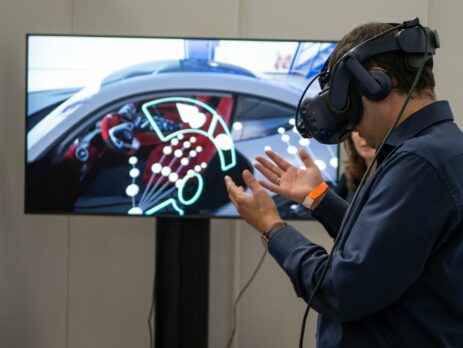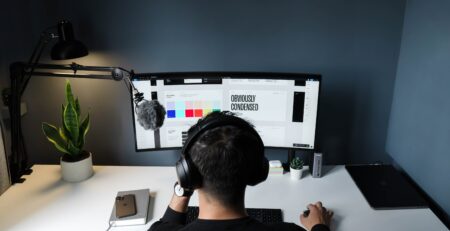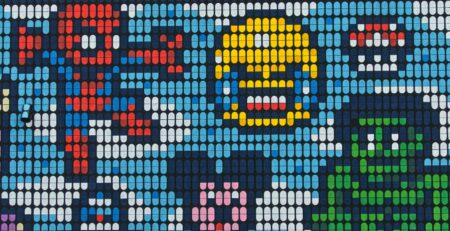Designing the Future: Recruiting AR (Augmented Reality) Designers
The realm of Augmented Reality (AR) is expanding rapidly, blending the digital and physical worlds in ways that were once confined to science fiction. As this technology progresses, the demand for skilled AR designers is skyrocketing, making the role of creative staffing agencies like iCreatives staffing more crucial than ever. These professionals are not just creating applications; they are crafting the experiences that will define the future of technology interaction.
AR designers are pivotal in turning complex technology into accessible and user-friendly applications. Their work involves more than just technical skills; it requires a deep understanding of human behavior, environment interaction, and design aesthetics. This multidisciplinary approach is what makes recruiting the right talent challenging and essential.
For businesses looking to integrate AR technology, the stakes are high. The success of AR applications depends heavily on the quality of the design and user interface, which directly impacts user engagement and satisfaction. This is where a specialized creative staffing agency like iCreatives staffing becomes invaluable, offering expertise in sourcing talent that can navigate the intricate landscape of AR design.
Recruiting AR designers requires a nuanced approach. It’s not just about finding someone with the right technical skills, but also about identifying individuals who can innovate and push boundaries. The ideal candidates are those who possess a unique blend of creativity, technical proficiency, and visionary thinking.
The challenges in recruiting AR designers are manifold. Firstly, the technology is still relatively new, and the pool of experienced designers is limited. This scarcity makes the recruitment process highly competitive. Creative staffing agencies must not only identify potential candidates but also attract and retain top talent by offering compelling opportunities and fostering a supportive environment.
Another challenge is the rapid pace of technological advancement in AR. What was cutting-edge a year ago may now be outdated. AR designers must continuously learn and adapt to new tools and trends. This necessity for ongoing education means that the recruitment process doesn’t end with hiring. Agencies and employers must provide opportunities for professional development to keep their designers at the forefront of the industry.
Understanding the specific needs of your project or company is crucial in recruiting the right AR designer. Each project may require different skills, such as 3D modeling, UX design, or coding expertise in specific AR platforms like ARKit or ARCore. A creative staffing agency can help clarify these requirements and find candidates who match the specific technical and creative demands.
The integration of AR technology into various industries is also creating diverse opportunities for designers. From retail and education to healthcare and automotive, AR is transforming how we interact with products and services. This expansion means that AR designers need to be versatile and able to apply their skills across different sectors.
As the demand for AR designers grows, so does the importance of effective recruitment strategies. Companies and staffing agencies need to be proactive in their recruitment efforts, utilizing both traditional methods and innovative approaches like social media outreach, specialized job fairs, and collaboration with educational institutions offering courses in AR and VR design.
In conclusion, the future of AR is bright, and the role of AR designers is becoming increasingly significant. Companies looking to stay ahead in this dynamic field must prioritize the recruitment of talented designers who can bring their visionary AR projects to life. Partnering with a specialized creative staffing agency like iCreatives staffing can provide the expertise and resources needed to meet these challenges head-on.
What qualifications should I look for in an AR designer?
When recruiting an AR designer, it’s crucial to look for a combination of technical skills and creative abilities. Key qualifications include proficiency in AR development platforms like Unity or Unreal Engine, experience with 3D modeling tools such as Blender or Maya, and a strong understanding of user experience (UX) principles. Additionally, candidates should demonstrate a portfolio of AR projects that showcase their ability to create engaging and functional AR experiences.
Education also plays a significant role in the qualifications of an AR designer. A degree in computer science, graphic design, or a related field can provide a solid foundation, but equivalent experience in AR development, particularly in a professional setting, can be just as valuable. Certifications in specific AR technologies and tools can further validate a candidate’s expertise and commitment to their craft.
Soft skills are equally important. AR design requires a collaborative approach, as projects often involve cross-functional teams. Look for candidates who are excellent communicators, team players, and problem solvers. The ability to accept and integrate feedback, adapt to changing technologies, and innovate within constraints are also critical traits.
Given the rapid evolution of AR technology, a passion for continuous learning is essential. Candidates who engage in ongoing professional development, whether through formal education, workshops, or self-study, are likely to keep pace with industry advancements and bring fresh ideas to your projects.
To assess these qualifications effectively, consider implementing a multi-stage interview process that includes technical assessments, creative challenges, and team interactions. This approach can help you gauge not only the candidate’s current capabilities but also their potential to grow with your company.
It’s also beneficial to involve current AR team members in the recruitment process. They can provide insights into the specific skills and qualities that are most valuable in your company’s AR projects, ensuring a better fit for the team and the goals of the organization.
Remember, diversity in skills and perspectives can enhance creativity and innovation in AR design. Consider candidates from various backgrounds and disciplines, as they can bring unique insights and approaches to your AR projects.
Finally, leverage the expertise of a creative staffing agency specialized in AR and VR placements. They can help you navigate the complexities of recruiting highly specialized talent and provide access to a broader pool of qualified candidates.
By focusing on these qualifications and utilizing a thorough assessment process, you can recruit AR designers who are not only technically proficient but also creatively innovative and ready to contribute to the success of your AR initiatives.
How do I assess the technical skills of AR designer candidates?
Assessing the technical skills of AR designer candidates is a critical step in the recruitment process. It ensures that the individuals you hire are capable of handling the specific demands of AR projects. The assessment can be approached through various methods, each providing insights into the candidate’s abilities and how they might perform in real-world scenarios.
One effective method is to conduct practical tests or assignments that simulate typical tasks they would handle on the job. For instance, you might ask candidates to design a basic AR experience using a specific platform or toolset. This not only demonstrates their technical proficiency but also gives you insight into their problem-solving and creative thinking skills.
Technical interviews are another essential component. These should be conducted by experienced AR professionals who can ask in-depth questions about the candidate’s experience and approach to design challenges. Questions might cover topics such as optimization for AR applications, understanding of spatial awareness in AR environments, and proficiency with AR development tools and languages.
Reviewing the candidate’s portfolio is also crucial. A strong portfolio should include detailed examples of past AR projects, highlighting the candidate’s role, the technologies used, and the design challenges overcome. Look for work that demonstrates a deep understanding of AR design principles and user engagement strategies.
It can also be beneficial to include scenario-based questions during the interview process. For example, ask how the candidate would improve an existing AR application or how they would handle specific technical challenges. This can help assess their ability to apply their technical knowledge creatively and effectively.
Peer reviews can provide additional insights into the candidate’s technical skills and ability to collaborate with others. If possible, arrange for them to work with your current team on a small project or during a trial period. This not only shows how they apply their skills in a team setting but also how they integrate with your company culture.
For more specialized roles, consider requiring certifications or training in specific AR platforms or tools. While not always necessary, these can verify a candidate’s commitment to their craft and their proficiency in the latest technologies.
Don’t overlook the importance of continuous learning and adaptability. AR technology evolves rapidly, and the best candidates are those who demonstrate a commitment to keeping their skills up-to-date. During interviews, ask about the courses, workshops, or seminars they have attended recently.
Utilizing a creative staffing agency that specializes in AR and tech placements can also streamline the technical assessment process. These agencies often have pre-vetted candidates and can provide guidance on the most effective assessment techniques for AR roles.
By employing a comprehensive and multi-faceted approach to assessing technical skills, you can ensure that your AR designer hires are well-equipped to contribute to your company’s projects and long-term success in the AR space.
What are the best practices for integrating AR designers into existing teams?
Integrating AR designers into existing teams can be a complex process, particularly if the existing team is unfamiliar with AR technology. Best practices for integration involve careful planning, education, and communication to ensure a smooth transition and effective collaboration.
Start with a structured onboarding process. This should include detailed introductions to the company’s current projects, tools, and workflows. It’s also important to provide comprehensive resources on the specific AR technologies and platforms the team is using.
Education plays a crucial role in integration. Consider hosting workshops or training sessions not just for the new AR designers but for the entire team. This fosters a better understanding of AR technology and its possibilities, which can inspire innovative ideas and collaboration across the team.
Encourage open communication. Regular meetings and updates can help ensure that everyone is on the same page and that the AR designers feel part of the team. These meetings should allow all team members to share their thoughts, progress, and any challenges they are facing.
Create opportunities for cross-disciplinary learning. Pairing AR designers with other team members in different roles can foster mutual understanding and spark innovative solutions that combine the strengths of various disciplines.
Set clear goals and expectations. It’s important that AR designers understand their role within the team and the specific contributions they are expected to make. Clear objectives not only guide their work but also help other team members understand how the AR designers fit into the project’s overall goals.
Provide mentorship and support. Pairing a new AR designer with a more experienced mentor can help them navigate the early stages of their integration. The mentor can offer guidance on both technical issues and company culture, which can be invaluable for a new hire.
Encourage feedback from both the AR designers and the existing team members. This feedback can provide insights into how the integration process is going and what might be improved. It’s important to address any issues early to prevent misunderstandings or dissatisfaction.
Utilize project management tools that enhance collaboration. Tools that support real-time updates, task tracking, and communication can help keep everyone aligned and facilitate smoother collaboration across different disciplines.
Recognize and celebrate the contributions of AR designers. Public acknowledgment of their work can boost morale and help other team members appreciate the value that AR designers bring to the project.
Finally, be patient. Integrating new technology and personnel takes time, and there will likely be a learning curve. A supportive, open, and flexible approach will go a long way in making the integration successful.

How can I attract top AR design talent to my company?
Attracting top AR design talent requires a combination of competitive compensation, appealing company culture, and opportunities for professional growth. To stand out in the competitive market for AR professionals, companies need to position themselves as leaders in innovation and technology.
Offer competitive salaries and benefits. AR designers are in high demand, and offering attractive compensation packages is crucial. Research industry standards to ensure your offers are competitive. Include benefits that are particularly appealing to tech-savvy professionals, such as flexible working conditions, health benefits, and opportunities for stock options or bonuses.
Highlight opportunities for innovation and creativity. Top talent is often driven by the chance to work on cutting-edge projects. Showcase your company’s commitment to innovation and the exciting AR projects you have underway. This can be done through your company’s website, social media, or in job postings.
Create a culture that values technology and innovation. A culture that encourages experimentation and continuous learning can be very attractive to AR designers. Promote your company’s culture in your recruitment materials and during interviews.
Invest in professional development. Offer opportunities for AR designers to advance their skills through workshops, courses, and conferences. This not only helps attract top talent but also retains them by showing a commitment to their career growth.
Utilize a specialized creative staffing agency. Agencies like iCreatives staffing have networks of pre-vetted talent and can help you connect with top AR designers quickly and efficiently.
Develop a strong employer brand. Your employer brand should communicate what makes your company unique and why it’s a great place to work. This can include everything from your company mission and values to employee testimonials and showcases of work-life balance.
Engage with the tech community. Participate in tech meetups, conferences, and seminars. Not only does this increase your visibility among potential hires, but it also keeps you informed about the latest industry trends and technologies.
Offer remote work options. The tech industry is increasingly embracing remote work, and offering flexibility can make your company more attractive to talent that values work-life balance or resides outside of traditional tech hubs.
Highlight the impact of their work. AR designers want to know that their work will make a difference. Clearly articulate how the role contributes to the company’s goals and the innovative ways their work will be utilized.
By focusing on these strategies, you can attract top AR design talent who are eager to contribute to your company’s success in the burgeoning field of augmented reality.
What are the common challenges in managing AR design projects?
Managing AR design projects presents unique challenges that stem from the innovative and technical nature of the work. Understanding these challenges can help you prepare and manage your projects more effectively.
One of the primary challenges is the rapid pace of technological change. AR technology is constantly evolving, with new tools and platforms emerging regularly. This can make project planning and execution difficult, as the tools or techniques decided upon at the start of a project may become outdated by its end.
Interdisciplinary collaboration is often necessary in AR projects, involving teams from different backgrounds such as software development, graphic design, UX/UI design, and more. Managing these diverse teams requires strong communication and coordination to ensure that all aspects of the project align and integrate seamlessly.
Another challenge is the high expectations for user experience in AR applications. AR designs need to be not only functional but also intuitive and engaging. Achieving this requires a deep understanding of user behavior and continuous testing and iteration based on user feedback.
Hardware limitations can also pose challenges. AR applications need to work across a range of devices with varying capabilities. Designers must therefore create flexible designs that can adapt to different screen sizes, processing powers, and graphic capabilities.
Budget constraints are a common issue as well. AR projects can be expensive, particularly if they require custom tools or high-end graphics. Effective budget management and resource allocation are crucial to prevent projects from exceeding financial limits.
Privacy and security concerns must also be addressed, especially as AR often involves the collection and processing of user data. Ensuring that your projects comply with relevant laws and regulations and safeguard user privacy is essential.
Keeping the project scope manageable can be challenging. The possibilities with AR can lead to scope creep, where the project expands beyond its original boundaries. This can delay project timelines and impact budgets.
Testing and quality assurance in AR can be more complex than in other types of projects. It requires thorough testing in real-world scenarios to ensure the AR application performs well under various conditions.
Finally, staying updated with AR trends and innovations is crucial. This requires ongoing research and learning, as well as networking with other professionals in the field to exchange knowledge and ideas.
By understanding these challenges and preparing for them, you can manage AR design projects more effectively, leading to successful outcomes and innovative solutions.
How does AR design impact user experience?
AR design significantly impacts user experience by enhancing the way users interact with the digital and physical worlds. It offers immersive experiences that can be both informative and entertaining, fundamentally changing how users perceive and interact with their environment.
One of the key impacts of AR design on user experience is increased engagement. By overlaying digital information onto the real world, AR makes interactions more compelling and memorable. This can be particularly effective in educational settings, where AR can transform traditional learning materials into interactive, 3D experiences.
AR also improves accessibility of information. Users can receive real-time information relevant to their location or the task at hand, which enhances decision-making and efficiency. For example, AR can display product details when a user points their device at an item in a store, or provide navigation cues directly overlaid on the real-world environment.
Moreover, AR can lead to more personalized user experiences. By utilizing data about the user’s preferences and behaviors, AR applications can tailor content and recommendations specifically to individual users, enhancing satisfaction and user engagement.
Furthermore, AR design can simplify complex tasks. In industries like manufacturing or healthcare, AR can provide workers with real-time, hands-on training or assistive information during tasks, reducing errors and improving performance. For instance, surgeons can use AR to visualize anatomy in three dimensions during procedures, which enhances precision and outcomes.
However, AR design must also address potential challenges to ensure a positive user experience. One major concern is user comfort. Poorly designed AR interfaces can lead to discomfort or even physical symptoms like motion sickness. Therefore, it’s crucial for AR designers to understand ergonomics and design interfaces that are intuitive and comfortable for long-term use.
Privacy is another critical aspect. As AR often uses cameras and sensors to interact with the user’s environment, it raises concerns about data security and privacy. AR designers must incorporate robust security measures to protect user data and build trust.
Additionally, AR design can sometimes lead to information overload if not carefully managed. Designers need to strike a balance between providing useful information and overwhelming users with too much data. Effective AR design should enhance the user’s environment and decision-making process without creating distractions.
The inclusivity of AR design also plays a vital role in user experience. Designing AR applications that are accessible to people with disabilities, such as incorporating voice commands or ensuring compatibility with assistive technologies, can broaden the user base and ensure a more inclusive approach.
In conclusion, AR design has a profound impact on user experience by transforming how users interact with the world around them. It offers opportunities for engagement, personalization, and simplification of tasks, but it also requires careful consideration of design principles to ensure comfort, privacy, and inclusivity. As AR technology continues to evolve, the role of AR designers will be increasingly crucial in shaping user experiences that are not only innovative but also user-friendly and secure.
What future trends should companies consider when recruiting AR designers?
As companies look to the future of AR technology, several trends are emerging that should be considered when recruiting AR designers. These trends not only highlight the evolving capabilities of AR but also the changing landscape in which these designers will operate.
One significant trend is the integration of AR with other technologies such as artificial intelligence (AI) and the Internet of Things (IoT). AR designers who are knowledgeable in these areas will be highly valuable as the combination of these technologies can lead to more intelligent and context-aware AR applications. For example, AR apps that can analyze real-time data from IoT devices to provide enhanced user interactions.
The rise of mobile AR is another trend shaping the industry. With smartphones becoming more powerful, AR applications are increasingly being developed for mobile devices. AR designers with experience in mobile app development and an understanding of mobile UX/UI design will be crucial as companies seek to tap into the widespread use of smartphones.
Furthermore, the use of AR in non-traditional sectors such as retail, marketing, and education is expanding. AR designers who can apply their skills across various industries and understand the specific needs and challenges of these sectors will be in high demand.
Another trend is the focus on creating more user-friendly AR experiences. As the technology becomes more mainstream, there is a greater need for designs that are accessible to all users, including those who are not tech-savvy. AR designers who can create intuitive and easy-to-use interfaces will be essential.
Lastly, ethical design in AR is gaining attention. As AR technology can collect and display personal data, designers must be adept at incorporating privacy and ethical considerations into their designs. This includes understanding regulations and best practices for data protection.
By keeping these trends in mind, companies can ensure they are recruiting AR designers who are not only skilled in current technologies but are also prepared for the future developments that will shape the AR industry. This forward-thinking approach will help companies stay competitive and innovative in the rapidly evolving AR landscape.
Conclusion
In conclusion, the recruitment of AR designers is a critical task for companies looking to innovate and lead in the augmented reality space. As AR technology continues to evolve, the need for skilled designers who can navigate the complexities of this technology becomes increasingly important. Companies must focus on attracting, hiring, and retaining the best AR talent by understanding the unique skills and qualifications these professionals bring.
Partnering with a creative staffing agency like iCreatives staffing can greatly facilitate this process. These agencies specialize in connecting companies with top-tier creative talent, equipped with the latest skills and insights into the AR industry. By leveraging their expertise, companies can streamline their recruitment process and ensure they have the right team to bring their AR visions to life.
Ultimately, the success of AR projects depends on the creativity and technical expertise of the designers behind them. As such, investing in the right talent is not just beneficial but essential for companies aiming to succeed in the competitive and fast-paced world of augmented reality.
In today’s competitive market, finding the right creative and marketing expert can be a challenge. But with icreatives, you’re in experienced hands. With 37 years in staffing and a track record of matching more than 10,000 employees to over 1,000 companies worldwide, we know how to connect you with the best. Plus, you only pay if you hire—there’s no risk, only results.
Ready to find your perfect creative or marketing expert? HIRE WITH ICREATIVES today!












